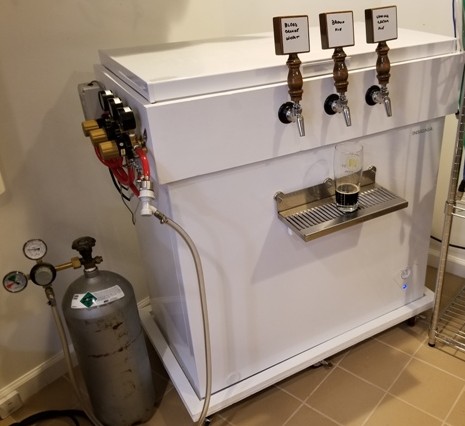Joeywhat
Well-Known Member
I'm about to pull the trigger on building a collar. I will be using 1x6" planks (probably cedar) for the exterior, and I'd like to use rigid foam insulation inside of that to keep my energy bill down. I have a couple snags that I need help with:
1) I was planning on also putting another 1x6 plank on the inside of the insulation to sandwich it in. My thought is that when I add taps and a CO2 bulkhead and whatever else I might have run through the collar, the wood on both sides will keep everything secure. Am I OK attaching shanks, bulkheads, etc. against the rigid insulation? Maybe use a big fender washer to keep from crushing it or having wobbly taps? Is it fine as is and I'm just overthinking it? The problem with adding the second plank inside is clearance with the lid, as it lowered right after the door seal, so the collar can only be so thick.
2) I'm planning on putting some sort of weather strip on both sides of the collar to help everything seal up. Not an issue between the collar and freezer, some adhesive backed foam strips are easy to install. Between the collar and the lid, it looks like the freezer door seal will land right between the wood and the rigid foam. My concern is that over time the rigid foam will deform and the seal will suck. Am I overthinking it again? Is there something I can attach to the top of the collar to make a smooth surface for the lid to seal on?
Thanks for the help everyone.
1) I was planning on also putting another 1x6 plank on the inside of the insulation to sandwich it in. My thought is that when I add taps and a CO2 bulkhead and whatever else I might have run through the collar, the wood on both sides will keep everything secure. Am I OK attaching shanks, bulkheads, etc. against the rigid insulation? Maybe use a big fender washer to keep from crushing it or having wobbly taps? Is it fine as is and I'm just overthinking it? The problem with adding the second plank inside is clearance with the lid, as it lowered right after the door seal, so the collar can only be so thick.
2) I'm planning on putting some sort of weather strip on both sides of the collar to help everything seal up. Not an issue between the collar and freezer, some adhesive backed foam strips are easy to install. Between the collar and the lid, it looks like the freezer door seal will land right between the wood and the rigid foam. My concern is that over time the rigid foam will deform and the seal will suck. Am I overthinking it again? Is there something I can attach to the top of the collar to make a smooth surface for the lid to seal on?
Thanks for the help everyone.











